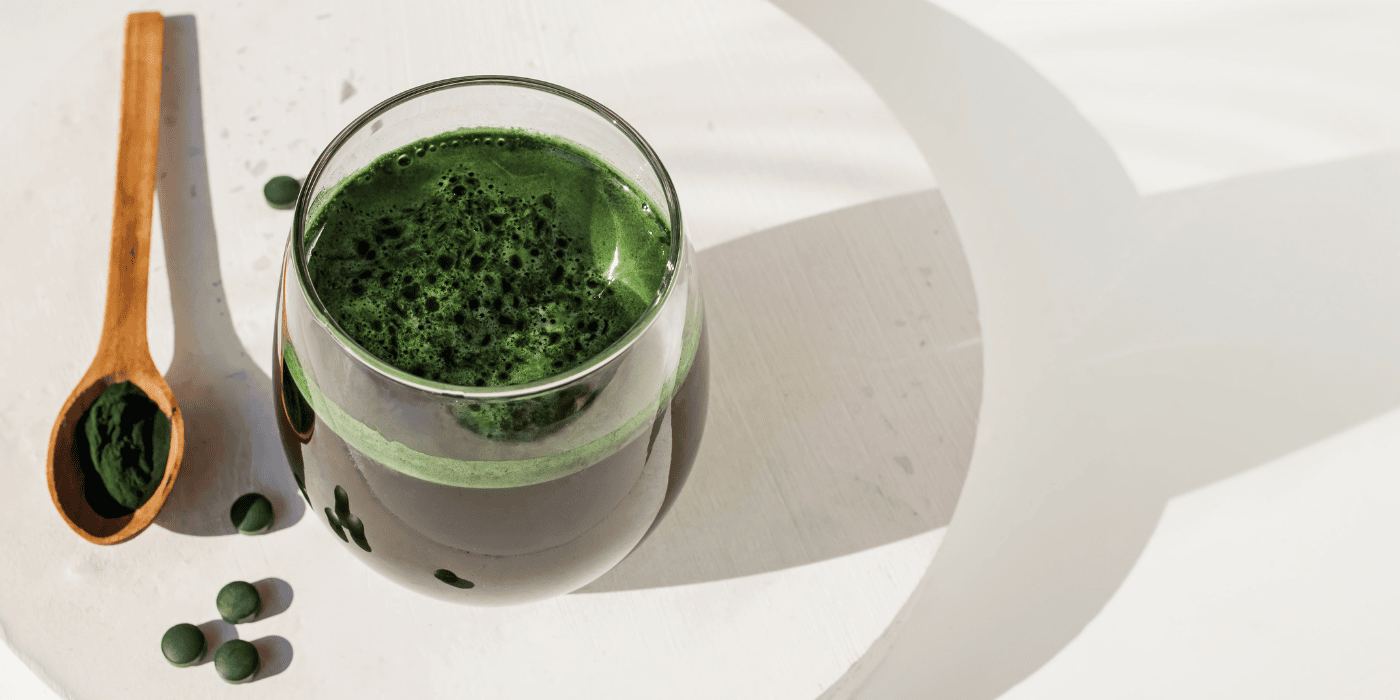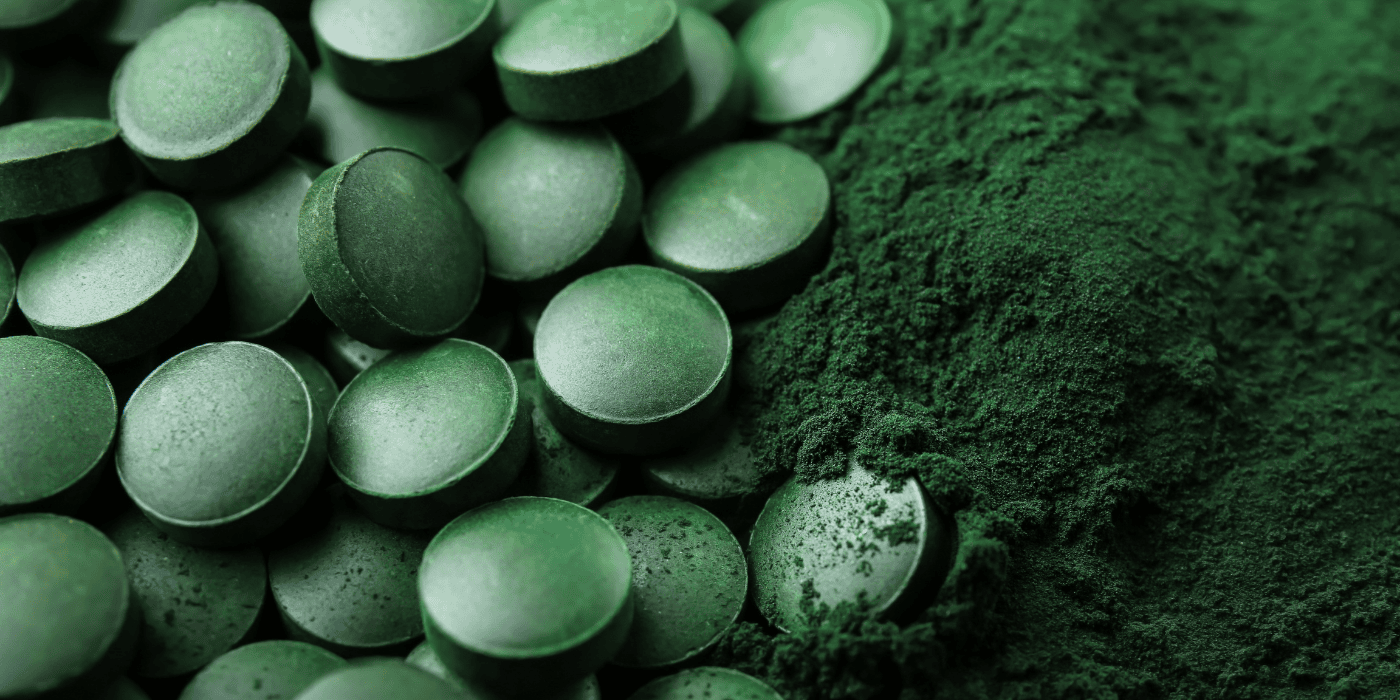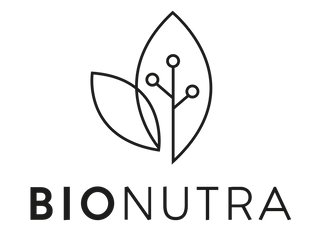Free shipping from 39 € (DE)
30-day return policy
Customer service from experts
4.9 Trustpilot rating
Free shipping from 39 € (DE)
30-day return policy
Customer service from experts
4.9 Trustpilot rating
APPLICATIONS
Chlorella – Superfood from the water: Information & Application
11 min read
Chlorella is a microalgae that has been used in Asia for centuries, but has only gained popularity in Europe in recent decades. It is considered a true "superfood" due to its high concentration of proteins, vitamins, minerals, and antioxidants. Of particular note is its ability to detoxify the body, as it can bind and eliminate heavy metals. It also supports the immune system, promotes digestion, and contributes to cardiovascular health.

1. Chlorella - briefly explained
Chlorella is a microalgae discovered in 1890 by Dutch biologist Martin Beyerink and named "Chlorella vulgaris"—from the Greek word "chloros" for green and the Latin word "ella" for small. Chlorella is classified as Chlorellaceae. The algae originated 1.5 to 2 billion years ago. It is a single-celled freshwater algae found in the wild in lakes and ponds around the world. Chlorella is between 2 and 10 micrometers in size (smaller than a red blood cell), and its green color and almost spherical shape can be seen under a microscope. There are about 20 different species of Chlorella, but Chlorella vulgaris is the most nutritionally interesting algae. Microalgae were already known to the Aztecs and some African tribes around the Great Lakes and have been used in Asia since ancient times. However, they remain largely unknown in Europe.
Chlorella algae contains a variety of valuable nutrients. It is rich in proteins, vitamins, minerals, and antioxidants. Its main ingredients include proteins, which make up approximately 50-60% of the algae and contain all essential amino acids. It is an excellent source of vitamin A, vitamin B12, vitamin C, and vitamin E. Chlorella also contains important minerals such as iron, calcium, magnesium, potassium, and zinc. A high chlorophyll content gives this microalgae its detoxifying properties. It also contains omega-3 fatty acids, which are important for heart health and brain function.
Taking chlorella can offer numerous health benefits. It can help remove heavy metals and other harmful substances from the body. Its antioxidant properties and high vitamin and mineral content boost the immune system. The fiber in chlorella promotes healthy digestion and can help regulate blood sugar levels. Thanks to its nutrient density, chlorella can contribute to increased energy and vitality. Omega-3 fatty acids and other nutrients can also help lower cholesterol and regulate blood pressure, which benefits cardiovascular health.
The recommended dosage can vary depending on individual needs and health goals, but is typically 2-5 grams per day. Chlorella algae is available in several forms, including powder that can be mixed into smoothies, juices, or water, as well as tablets and capsules that are easy to take and ideal for on-the-go use. Liquid extracts offer a concentrated form of the green ingredients that can be easily mixed into water or juice.
A few things to keep in mind when using it. It's important to use high-quality products, preferably organic, to avoid contaminants. Start with a low dosage and increase it slowly to avoid possible digestive upset. People with algae allergies or intolerances should avoid chlorella. Furthermore, chlorella naturally contains sulfite compounds.
2. How is Chlorella cultivated?
Chlorella algae are cultivated in both open ponds and closed systems called photobioreactors. Open ponds are a traditional method, especially in sunny regions. These shallow and spacious ponds allow maximum sun exposure and utilize mechanical or hydraulic means to continuously circulate the water. This ensures an even distribution of nutrients and algal cells. The main advantages of this method are its low cost and high production capacity. However, there is an increased risk of contamination by foreign algae, bacteria, and other microorganisms, and weather conditions can affect algae growth and quality.
Closed systems, or photobioreactors, provide a controlled environment for growing the microalgae Chlorella. These often consist of transparent tubes or containers that allow for precise control of light intensity, temperature, pH, and nutrient concentration. This minimizes the risk of contamination and ensures consistently high product quality. Optimized conditions lead to higher growth rates and nutrient density. These systems enable production in various climates, independent of external conditions, but they involve higher initial investment and operating costs and require complex maintenance.
The production process begins with the cultivation of a pure starter culture in small reactors or laboratory environments. This culture is gradually transferred to larger cultivation systems, with conditions further optimized to maximize cell growth. After the growth phase, which varies depending on the system and environmental conditions, the algae are harvested. This is usually done by centrifugation or filtration to separate the algal cells from the water. The harvested chlorella is then dried to increase shelf life and allow for easy further processing. Methods such as spray drying or freeze-drying are often used to preserve nutrient integrity. After drying, the algae are processed into various forms such as chlorella powder, chlorella tablets/pressed pellets, or capsules.
Strict quality control is essential throughout the entire production process. Regular testing for microbiological contamination, nutrient content, and heavy metals ensures that products meet the highest quality and safety standards. Certifications such as organic standards or GMP (Good Manufacturing Practice) contribute to this.
Chlorella cultivation is considered sustainable because the algae absorbs CO2 and produces oxygen. Compared to traditional agricultural methods, cultivation requires less water and land. Advances in technology and more efficient farming methods are helping to further minimize the ecological footprint. By combining traditional techniques with modern technologies, chlorella cultivation offers a sustainable and efficient way to produce a valuable source of nutrients.

3. Chlorella algae as a dietary supplement - What ingredients does it contain?
Contrary to popular belief, Chlorella is not a close relative of Spirulina. Spirulina belongs to the cyanobacteria family and is therefore a prokaryotic microbial organism, meaning its nucleus is not individualized by a nuclear membrane. Chlorella is a distinct microscopic alga, a eukaryotic organism with a distinctly membrane-enclosed nucleus rich in chlorophyll and cellulose.
Chlorella is naturally rich in nutrients. Proteins make up more than 50% of its composition. These proteins contain essential amino acids needed by the human body. Pigments, including chlorophyll and lutein, are present in exceptionally high concentrations. Chlorophyll, which gives these plant cells their green color, is known for its detoxifying properties. Lutein is an important antioxidant that protects the eyes and skin.
Chlorella also contains a variety of lipids, including polyunsaturated essential fatty acids of the omega-3 type, similar to those found in flaxseed and lamb's lettuce. These fatty acids are important for heart health, brain function, and reducing inflammation in the body.
Chlorella is also rich in vitamins, particularly vitamins B1, B6, and B12, which are normally found in meat and dairy products. Chlorella can therefore be an important source of these vitamins for vegetarians and vegans.
Vitamin B12 : 80 to 180 micrograms per 100 grams
Vitamin E : 8 to 11 milligrams per 100 grams
In addition, there are a variety of minerals and trace elements: potassium, calcium, magnesium, iron, zinc, selenium
Another important point is that chlorella has a very low iodine content, so it can be consumed even if you have thyroid problems. This makes chlorella a safe supplement for people with iodine sensitivities.
4. Chlorella Effects and Benefits

Heavy metals
Studies have shown that chlorella is able to bind toxic pollutants such as dioxins and organochlorine aromatic compounds, especially PCBs.
The cell membrane of chlorella has the ability to bind and store heavy metals and chemicals present in the body. It thus supports the natural elimination of toxins such as mercury, cadmium, lead, and arsenic.
The sporopollenin it contains can also bind heavy metals and toxins and transport them to the intestine, where they can be excreted.
regeneration
Chlorella contains Chlorella Growth Factor (CGF), which gives it its exceptional ability to regenerate cells. Four new cells are formed from one cell every 20 hours, thanks to its unique composition of vitamins, amino acids, and natural sugars. Consuming Chlorella thus promotes cell regeneration in the human body, leading to faster wound healing, better protein absorption, and generally improved body function.
Dietary supplement and protein source
More than 4 million Japanese consume chlorella daily, making it the most important dietary supplement in Japan. With a protein content of 58%, chlorella is even richer in protein than soy (35%). These proteins are easily digestible and provide 19 different amino acids, including the eight essential amino acids. The biological value of the proteins in chlorella is high, exceeding that of grains.
Chlorophyll
Chlorella has a very high chlorophyll content, which gives it its characteristic green color. Chlorophyll is particularly beneficial for the intestinal flora, as it supports its regeneration. It also has the ability to transport oxygen while cleansing the body. The pigments, especially chlorophyll and lutein, are present in exceptionally high concentrations in chlorella, far higher than in spinach, and is therefore considered a "super vegetable."
Other vital substances
Chlorella is not only an excellent source of protein, but also contains a variety of vitamins (A, B, C, E, and B12) and minerals (iron, calcium, magnesium, zinc, potassium, sulfur, and manganese). It also contains fiber, which promotes intestinal well-being. The detoxifying properties of fiber support intestinal health. Chlorella also contains polyunsaturated essential fatty acids of the omega-3 type, similar to those found in flaxseed and lamb's lettuce. These fatty acids are important for heart health and brain function.
5. Chlorella use: dosage, consumption and side effects
dosage
For a short treatment, 2 to 4 grams of chlorella per day is generally recommended. The dosage can vary depending on individual needs. For specific detox treatments or health concerns, a higher dosage may be beneficial, but should be discussed with a specialist.
Form of consumption
Chlorella is available as chlorella tablets and powder, and in combination with spirulina as organic chlorella-spirulina powder and tablets. The powder can be easily mixed into smoothies, juices, or water, while the tablets can be conveniently taken with water.
pregnancy
Studies show that chlorella may be beneficial during pregnancy, reducing dioxin concentrations in breast milk by about 30% when taken daily at 6 grams. There are no known risks associated with higher doses, but if you have individual concerns, discuss taking it with a doctor beforehand.
Chlorella side effects
Mild digestive discomfort may occur when you first start taking it, so it's advisable to start with a low dose and increase it slowly. Chlorella should ideally be taken on an empty stomach or before meals. Drinking plenty of water supports the detoxification process.
Allergies and intolerances
Chlorella naturally contains sulfites, which can trigger allergies in sensitive individuals. People with known sulfite allergies should consult their doctor before taking chlorella to avoid possible allergic reactions.
6. Frequently asked questions
What is the difference between microalgae spirulina and chlorella algae?
Spirulina and Chlorella differ primarily in their biological classification and nutrient composition. Spirulina belongs to the cyanobacteria and is prokaryotic, meaning it lacks a true cell nucleus. Chlorella is a eukaryotic algae with a true cell nucleus. Spirulina has a higher protein content and more B vitamins, while Chlorella contains more chlorophyll, iron, and essential fatty acids. Chlorella is often used for detoxification, while Spirulina is valued for energy and immunity.
Does Chlorella really provide enough real vitamin B12?
Chlorella contains vitamin B12, but its bioavailability and the amount of usable B12 in chlorella are controversial. Evidence suggests that much of the vitamin B12 in chlorella is in a form that cannot be effectively utilized by the human body. Therefore, chlorella may not be a reliable source of vitamin B12 for vegetarians and vegans who rely on adequate intake of this vitamin. Vitamin B12 supplementation may be necessary.
Are the cell walls of the organic Chlorella Vulgaris tablets broken?
The cell walls of organic Chlorella vulgaris tablets are often mechanically disrupted to improve nutrient availability. This process, known as cell disruption or cell wall rupture, facilitates digestion and absorption of nutrients by the human body. It is advisable to consult the product description or the manufacturer to ensure that the tablets have undergone the desired cell disruption.
Would you prefer pure Chlorella algae or mixed with Spirulina algae?
The decision between a pure chlorella algae product or a mixture of chlorella and spirulina depends on individual health goals and preferences:
Pure Chlorella Algae Product: If your primary goal is detoxification and supporting digestive health, a pure chlorella product may be the best choice. Chlorella is known for its ability to bind heavy metals and detoxify the body. It also contains a wealth of nutrients such as vitamins, minerals, and proteins.
Chlorella and Spirulina Blend: If you're looking for a broader range of nutrients, including higher protein intake and additional antioxidants, a combination of chlorella and spirulina may be beneficial. Spirulina contains more protein than chlorella and provides additional essential amino acids and vitamin B12. This blend may support immune health, energy, and endurance.
Does chlorella help detoxify the body?
Chlorella is often used to support detoxification. The algae has the ability to bind and remove heavy metals such as mercury, lead, and cadmium, as well as other toxic compounds, from the body. This occurs through a process called chelation, in which Chlorella traps these pollutants within its cellular structure and then excretes them through the stool.
Chlorella also contains chlorophyll, which supports the body's detoxification function by assisting the liver in neutralizing toxins and promoting digestion. In addition, chlorella has anti-inflammatory and antioxidant properties, which also contribute to cleansing and regenerating the body.
Chlorella pyrenoidosa or vulgaris – which is better for detoxification?
Both Chlorella species, vulgaris and pyrenoidosa, are well-suited for detoxification. Pyrenoidosa has slightly higher chlorophyll and protein contents, while vulgaris contains more natural nutrients such as iron and vitamin B12. The choice depends on individual needs.
Is Chlorella suitable for vegetarians?
Yes, it's very suitable for vegetarians. It's rich in fiber and protein (+50%) and works on three levels:
Detoxifying effect : If you're starting a weight-loss diet, chlorella helps cleanse your body, making your diet more effective.
Poisoning : If you are affected by toxins, chlorella helps eliminate them naturally. It contributes to the excretion of heavy metals.
Digestion : Chlorella regulates acid-base pH and gently speeds up the passage and helps reduce flatulence.
Is Chlorella suitable for salt-free diets?
Chlorella has a very low iodine content, making it suitable for consumption in cases of thyroid problems. At the same time, it contains trace elements and minerals essential to the body: iron, zinc, potassium, magnesium, calcium, manganese, phosphorus, and selenium.
The microalgae is highly valued, especially for its iron content, which is better absorbed than that found in plants. Because chlorella is cultivated in freshwater, it contains no iodine and has a low sodium content, making it an acceptable food in a salt-controlled diet.
Do Chlorella algae have increased heavy metal contamination?
Chlorella algae has the ability to bind heavy metals such as mercury, lead, and cadmium, which can raise concerns about potential heavy metal contamination. However, this does not necessarily mean that chlorella algae itself has elevated levels of heavy metal contamination. The quality of the growing area and manufacturing practices are crucial. High-quality, certified organic chlorella products are cultivated in controlled environments and subject to strict quality standards to ensure they are free of heavy metals and other contaminants. It is important to look for high-quality products from trusted manufacturers and to ask questions about the cultivation and purity of the chlorella algae if necessary.
Pregnancy and breastfeeding: Is taking chlorella safe?
Some studies suggest that chlorella may be beneficial during pregnancy by reducing dioxin levels in breast milk. However, pregnant women and breastfeeding mothers should consult their doctor before taking chlorella.
7. Conclusion
Chlorella is a nutrient-rich microalgae that offers a variety of health-promoting ingredients such as proteins, vitamins, minerals, and antioxidants. It supports the body's detoxification, strengthens the immune system, and promotes cardiovascular health. It is cultivated in open ponds or controlled photobioreactors, adhering to high quality standards. Its versatile availability as a powder or tablets allows for easy integration into the diet. Despite its numerous benefits, individual needs, allergies, and potential interactions should be discussed with a physician. Overall, chlorella is a valuable addition to a healthy diet.
More articles:
Microalgae
Spirulina algae
Sources:
Panahi Y, Darvishi B, Jowzi N, Beiraghdar F, Sahebkar A. Chlorella vulgaris: A Multifunctional Dietary Supplement with Diverse Medicinal Properties. Curr Pharm Des. 2016;22(2):164-173. doi:10.2174/1381612822666151112145226
Barkia I, Saari N, Manning SR. Microalgae for High-Value Products Towards Human Health and Nutrition. Mar Drugs. 2019;17(5):304. Published 2019 May 24. doi:10.3390/md17050304
Barghchi H, Dehnavi Z, Nattagh-Eshtivani E, et al. The effects of Chlorella vulgaris on cardiovascular risk factors: A comprehensive review on putative molecular mechanisms. Biomed Pharmacother. 2023;162:114624. doi:10.1016/j.biopha.2023.114624
Leave a comment
Comments will be approved before showing up.
















